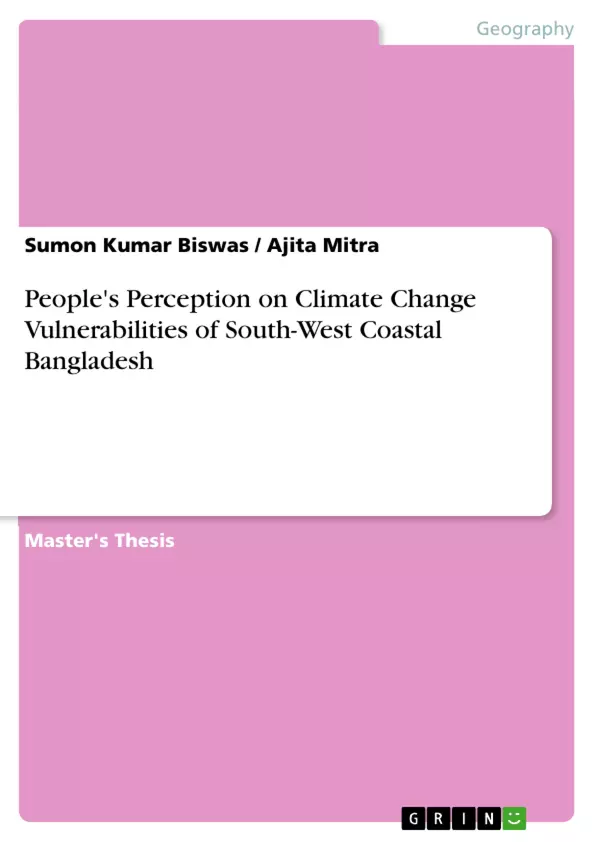This study aims to measure the people’s perception regarding climate change vulnerabilities in south-west coastal Bangladesh. The broader objective of the study is to assess the climate induced vulnerabilities and to view their adaptive capacity with the climate change vulnerabilities. Both purposive and simple random samplings were used to conduct this study. Data were collected from 120 respondents through interview schedule technique. In the interview schedule technique, question was asked and filled by the interviewers in face-to-face situation.
Climate induced changes such as extreme cyclone, devastating tidal surges, severe floods, tremendous river erosion, excessive rainfall, overwhelming salinity intrusion etc, are occurring more frequently in greater intensities and in an unpredictable manner around the world including Bangladesh. To perceive the vulnerability, the southwestern coastal Bangladesh is selected as a research area where high vulnerability to natural climate is due to its low lying delta. The research mainly focuses on the perception level of the people on climate change vulnerability and its impact on their livelihood patterns. The research revealed that various climatic events adversely affect the people of the study area. Among all natural disasters like cyclone affects severely the livelihood pattern of the study area. Peoples of the affected area experienced that disproportionate rate of salinity intrusion into the land mass increased less fertility that causes failure of crop production. As a consequence, most of the low income families are now facing food insecurity and a huge amount of potable water crisis that makes the people more vulnerable along with a threat of different water borne diseases. Finally consideration of the mentioned vulnerable factors, a simplified adaptation strategy based on the respondent view is recommended. The findings of this study explicate that climate change resulted the vulnerability of the people in the coastal areas of Bangladesh.
Inhaltsverzeichnis (Table of Contents)
- Chapter One: Introduction
- 1.1 Statement of the Problem
- 1.2 Rationale of the Study:
- 1.3 Objective of the Study:
- 1.4 Literature Review:
- 1.5 Operational Definition of Concepts:
- 1.6 Conceptual Framework:
- 1.7 Importance of the Study...
- 1.8. Limitations of the Study
- Chapter Two: Methodology of the Study
- 2.1 Methodology of the Study:
- 2.2 Physical profile of the Study Area:
- 2.3 Map of the Study Area:..
- Chapter Three: Understanding Climate Change..
- 3.1 Understanding the Climate Change …..
- Chapter Four: Data Analysis
- 4.1: Socio-economic and Demographic Characteristics of the Respondents:
- 4.2: Perception Assessment Regarding Climate Change:……….
- 4.3: Vulnerability Assessment due to Climate Change:
- 4.4: Adaptation Strategies of the Respondents ....
- Chapter Five: Major Findings, Recommendations and Conclusion..
- 5.1 Major findings, Recommendations and Conclusion:..
- 5.2 Recommendations
- 5.3 Concluding Remarks:
Zielsetzung und Themenschwerpunkte (Objectives and Key Themes)
This study explores the perception of climate change vulnerabilities in South-West Coastal Bangladesh. The research aims to understand the local population's awareness of climate change, their perceived vulnerabilities, and their adaptation strategies.
- Understanding the local population's perception of climate change and its impacts
- Analyzing the perceived vulnerabilities of the population to climate change
- Assessing the adaptation strategies implemented by the community to mitigate climate change risks
- Identifying socio-economic and demographic factors that influence climate change perception and vulnerability
- Providing recommendations for effective climate change adaptation policies and interventions
Zusammenfassung der Kapitel (Chapter Summaries)
Chapter One introduces the study, outlining the problem, rationale, objectives, and conceptual framework. It defines key concepts and discusses the importance and limitations of the research. Chapter Two details the methodology used, including the study area and data collection methods. Chapter Three provides an overview of climate change and its impacts on the study area. Chapter Four presents the data analysis, examining socio-economic and demographic characteristics, perception of climate change, vulnerability assessment, and adaptation strategies. Chapter Five summarizes the major findings, provides recommendations, and concludes the study.
Schlüsselwörter (Keywords)
Climate change, vulnerabilities, perception, adaptation, South-West Coastal Bangladesh, socio-economic factors, demographic characteristics, data analysis, recommendations.
- Citation du texte
- Sumon Kumar Biswas (Auteur), Ajita Mitra (Auteur), 2009, People's Perception on Climate Change Vulnerabilities of South-West Coastal Bangladesh, Munich, GRIN Verlag, https://www.grin.com/document/321764



